There are a variety of materials for fireproof clothing, and different materials provide different protective properties, especially high temperature resistance, flame retardant, chemical corrosion resistance, and so on. Fireproof clothing is usually made of natural fibers, synthetic fibers, or composite materials, depending on the application scenario and the level of protection required. Here are some common fireproof clothing materials:
Flame-retardant cotton protective clothing
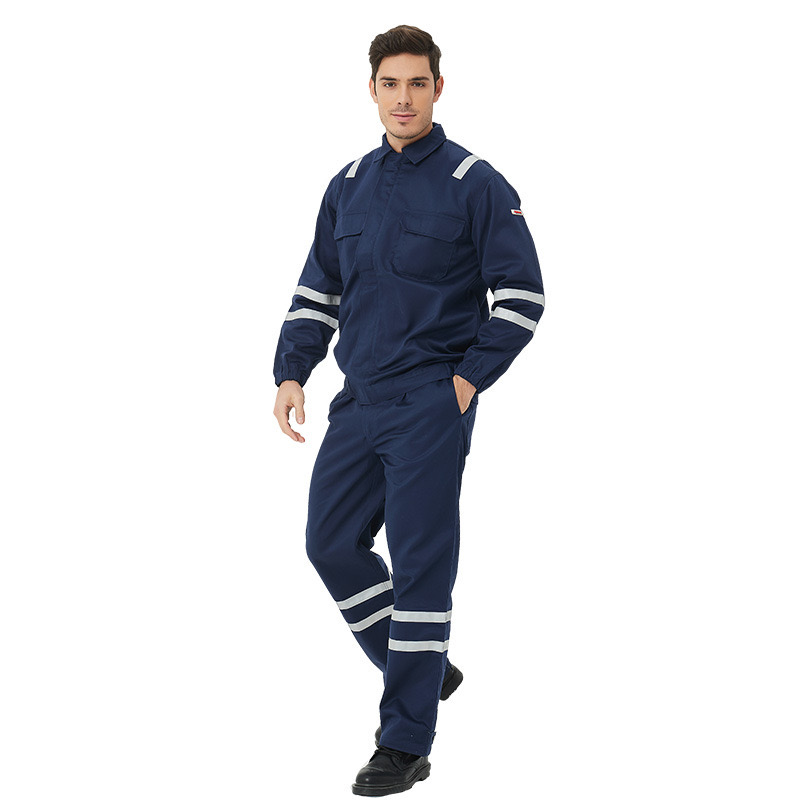
Flame-retardant cotton protective clothing is made of natural cotton fabric by chemical flame-retardant treatment so that it has flame-retardant properties. This type of protective clothing is more economical and is a more common medium-fire protection solution.
Advantages:
- Comfort: cotton fiber is soft and breathable, comfortable to wear, and especially suitable for long working occasions.
- Moderate price: flame-retardant cotton protective clothing is relatively low cost and is an affordable choice for most workers, suitable for projects with limited budgets.
- Better flame retardant performance: the chemically treated cotton fiber has a certain flame retardant, can effectively prevent the spread of flame, and is safe enough in the general working environment.
Cons:
- Decreased flame retardant performance: With the increase of washing times, the flame retardant performance of flame retardant cotton will gradually decline, and the protective effect may be significantly weakened after 25-50 times of washing.
- Poor durability: compared with synthetic fibers such as aramid, cotton fibers have poor wear resistance and a shorter service life.
- Weak high temperature resistance: flame-retardant cotton is suitable for medium flame and heat source environments, but it does not perform as well as aramid or other high-performance materials in extreme high temperature environments.
Application field:
- General industrial protection: suitable for use in factories, manufacturing, construction, and other scenarios requiring moderate fire protection, such as welders and chemical workers.
- Projects with limited budgets: Budget-sensitive businesses are more inclined to use flame-retardant cotton protective clothing because it can control costs while providing appropriate protection.
Service life:
The flame retardant effect of flame retardant cotton may begin to decrease significantly after 25–50 washes, so regular replacement is necessary. Its service life is usually 1-3 years, depending on the frequency of wear and washing maintenance.
Polyester-cotton blended flame retardant protective suit
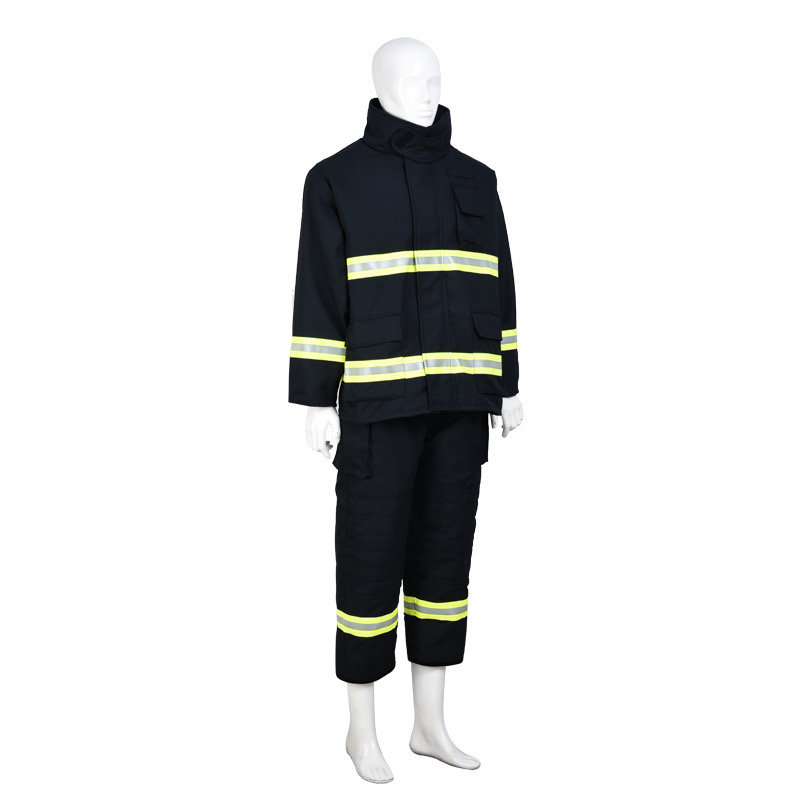
Polyester and cotton blended protective clothing is made of polyester (polyester) and cotton blended, and through flame retardant treatment to obtain flame retardant properties. Polyester-cotton blended fabrics combine the wear resistance of polyester with the comfort of cotton and are widely used in light and medium fire protection environments.
Advantages:
- Good wear resistance: Due to the addition of polyester, blended fabrics are more wear-resistant than pure cotton fabrics and can better cope with daily wear and pull.
- Combination of comfort and economy: poly-cotton blended protective clothing is more comfortable than pure polyester or pure cotton protective clothing, and its price is relatively low, suitable for medium-budget projects.
- Good wrinkle resistance: Polyester fiber has good wrinkle resistance, so the polyester and cotton blend material is not easy to wrinkle when wearing, and the appearance is kept tidy.
Cons:
- Limited flame retardant performance: the flame retardant performance of poly-cotton blend depends on the effect of chemical treatment, and the flame retardant effect may be gradually lost after washing times.
- Poor high temperature resistance: polyester will melt at high temperatures, and the protective effect of blended materials in extremely high temperature environments is not as good as that of professional materials such as aramid or PBI.
- The flame retardant effect decreases faster: similar to flame retardant cotton, the flame retardant performance of poly-cotton blended materials will decrease with the number of washing times, and the performance is limited at high temperatures.
Application field:
- Light industrial protection: suitable for low- and medium-risk working environments, such as construction sites, electrical maintenance, and other fields.
- Daily work clothes: suitable for those who need a certain flame protection and require a comfortable and economic working environment.
Service life:
The flame retardant performance of polyester-cotton blended protective clothing can maintain about 20–50 washes, depending on the quality of the flame retardant. The overall service life is generally 1-3 years, depending on the washing frequency and use environment.
Aramid fiber protective clothing
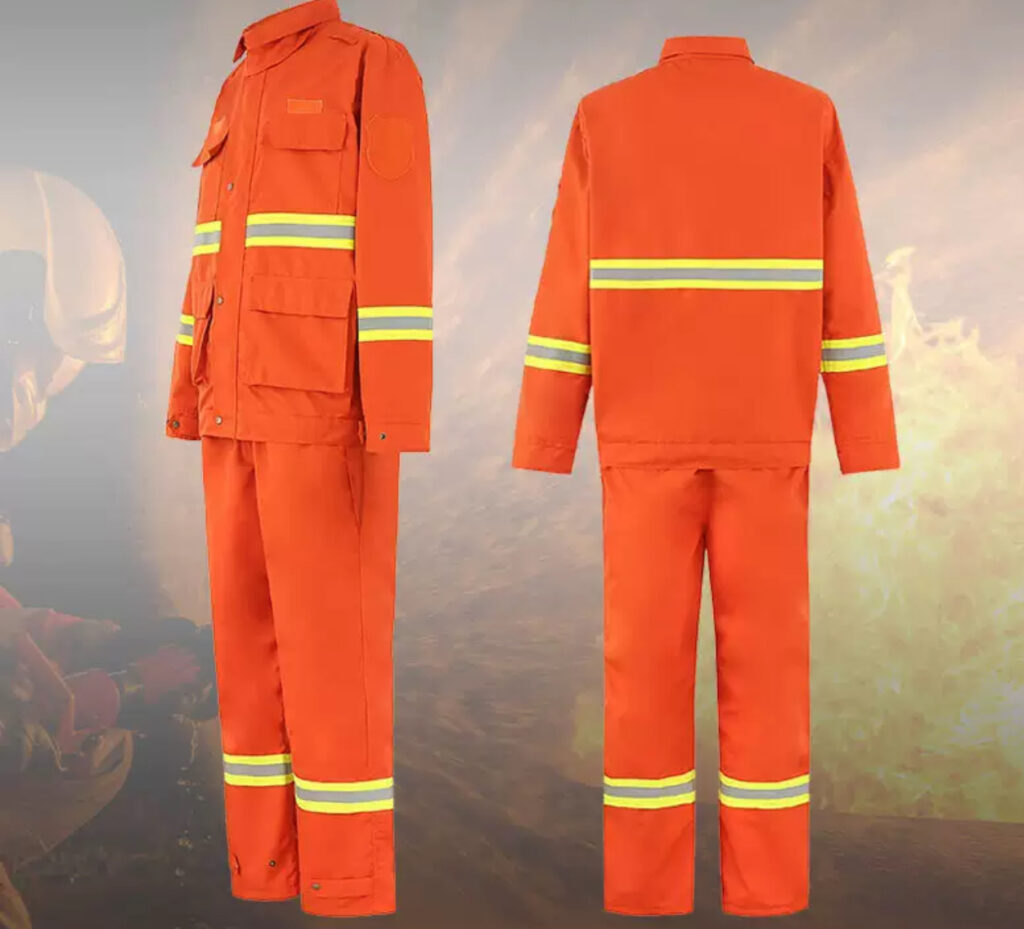
Aramid is a synthetic fiber that has excellent heat resistance, flame retardant, and mechanical damage resistance and is often used in the manufacture of high-performance protective clothing. The most common brands of aramid fiber include Nomex and Kevlar, which have a wide range of applications in the field of fire protection and protection.
Advantages:
- Intrinsic flame retardant: aramid fiber itself has flame retardant properties and does not require additional chemical treatment. Even at high temperatures, aramid fibers do not burn, melt, or drip.
- High temperature resistance: Aramid fiber can withstand temperatures of up to 400°C and is especially suitable for extreme high temperature environments, such as protective clothing for firefighters or metallurgical workers.
- Lightweight: Compared with other high-performance protective materials, aramid fiber protective clothing is more lightweight, increasing the comfort and flexibility of wearing.
- Durable: aramid fiber has high wear resistance and tear resistance, can be used in harsh working environments for a long time, and the protective performance is not significantly reduced due to multiple washings.
Cons:
- High cost: The production cost of aramid fiber protective clothing is high, and the price is usually much higher than that of flame-retardant cotton and blended materials, which is suitable for higher budget scenarios.
- Uv resistance is general: although aramid fiber performs well in high-temperature environments, it may gradually degrade under long-term exposure to ultraviolet light, affecting life.
Application field:
- Firefighters, military, and aviation fields: Aramid protective clothing is widely used in high-risk occupations such as fireproof clothing for firefighters, military combat clothing, and pilot protective clothing.
- High temperature and arc protection: suitable for metallurgical and electric power industry workers, especially in the need to fight against high temperature, flame, or arc scenes.
Service life:
The flame-retardant properties of arylon fiber protective clothing will not disappear due to washing and can usually withstand more than 50 times of washing. Its overall service life is usually about 5-10 years, depending on the frequency of use and the environment.
Aluminum foil composite fireproof clothing
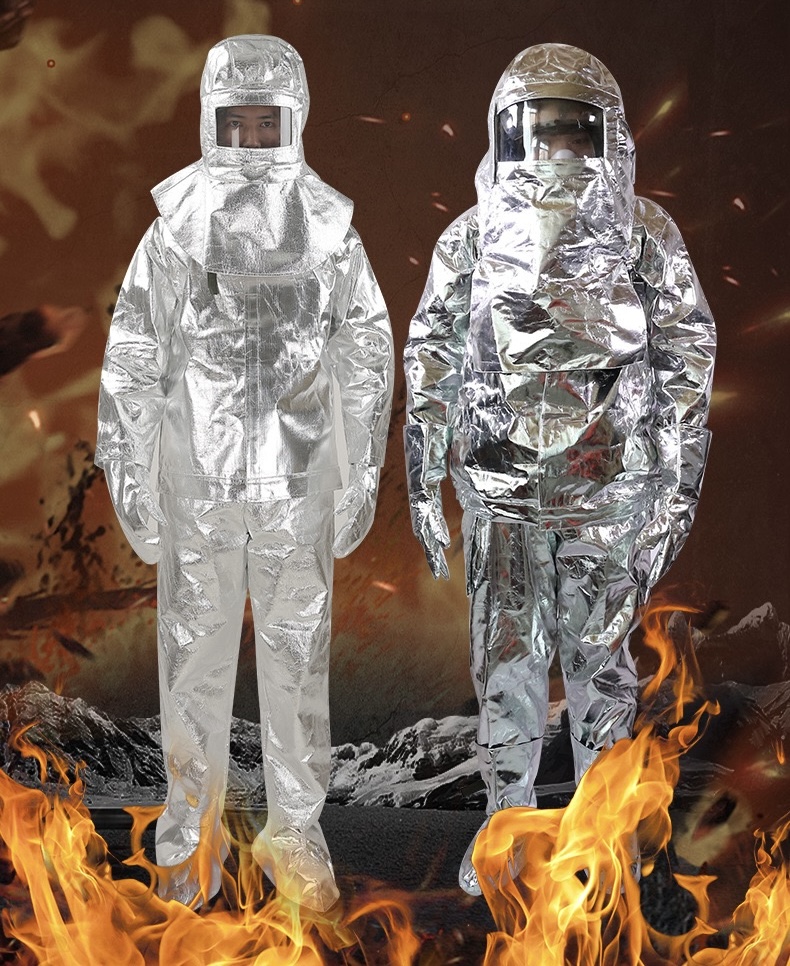
Aluminum foil composite fire retardant clothing is composed of aluminum foil and other flame retardant materials (such as arnylon or glass fiber), mainly used to reflect high temperature thermal radiation to protect the wearer from strong thermal radiation damage. The aluminum foil surface reflects most of the heat, providing excellent thermal protection.
Advantages:
- Reflection of high-temperature thermal radiation: Aluminum foil has excellent thermal reflection performance and can reflect more than 90% of thermal radiation, especially suitable for high-temperature radiation environments.
- Good flame retardant performance: A composite material layer (such as arnylon or glass fiber) further enhances the flame retardant effect of fire retardant clothing, which can effectively resist direct flame contact.
- Waterproof, oil, and chemical resistant: the aluminum foil layer can prevent the erosion of water, oil, and some chemicals and is widely used in a variety of complex working environments.
- High strength: After aluminum foil is combined with fiber material, the fireproof clothing has high tear resistance and mechanical damage resistance.
Cons:
- Heavier weight: Due to the existence of aluminum foil, the weight of the fireproof suit is larger, and long-term wearing may affect action and comfort.
- Poor flexibility: the rigidity of aluminum foil is strong, although composite materials can improve certain flexibility, but the overall softness is still not as good as pure fiber materials.
- Vulnerable to mechanical damage: the aluminum foil surface may be damaged when it is collided or scratched by sharp objects, resulting in a weakened protective effect.
Application field:
- High temperature radiation environment: Aluminum foil fireproof clothing is especially suitable for workplaces with high temperature radiation, such as steel mills, glass manufacturing, foundries, etc., which require a lot of reflecting heat.
- Firefighter protection: In the process of extinguishing the fire, the aluminum foil fireproof suit can effectively reflect the thermal radiation generated by the flame and reduce the damage of high temperatures to personnel.
- Metallurgical industry: In the operation of high temperature furnaces, aluminum foil fireproof clothing can provide effective high temperature protection, especially to prevent radiant heat.
Service life:
The life of aluminum foil composite fireproof clothing is usually about 3-5 years, but the specific life depends on the use environment, frequency, and maintenance. Frequent mechanical damage or exposure to harsh chemical environments may accelerate the damage of the aluminum foil layer and shorten its service life. Therefore, regular inspection and proper maintenance are the keys to extending its service life.
Carbon fiber fabric fireproof clothing
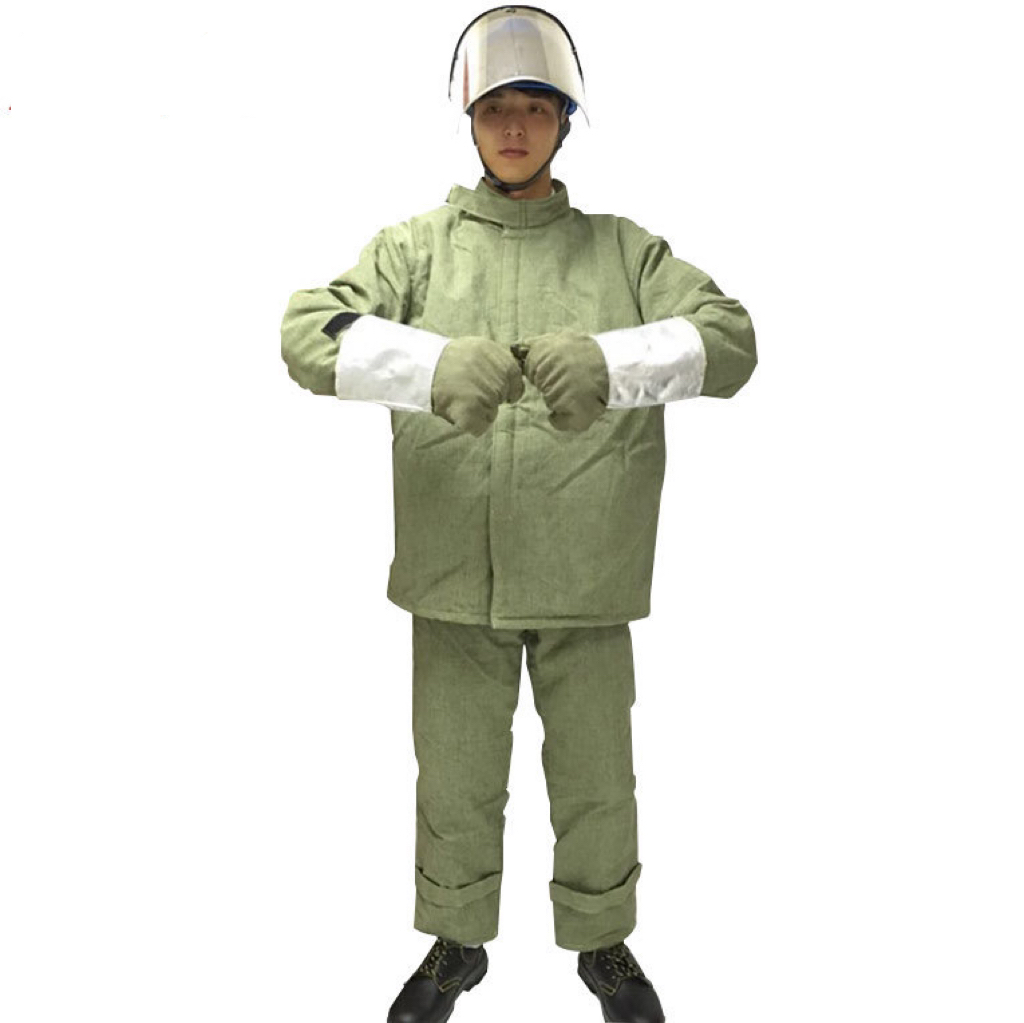
Carbon fiber fabric is a high-performance material that, because of its excellent heat resistance and flame retardancy, is widely used in fireproof clothing. Carbon fiber is made of organic fiber after high-temperature pyrolysis carbonization treatment, with extremely high strength, stiffness, and heat resistance.
Advantages:
- Extremely high heat resistance: carbon fiber will not melt or burn at high temperatures and can withstand extreme temperatures of up to 3000 °C, so it is widely used in the field of fire protection.
- Light weight: carbon fiber has a low density and is lighter than traditional fireproof clothing materials, increasing the comfort of the wearer.
- Tear and mechanical resistance: Carbon fiber has excellent tear resistance, impact resistance, and wear resistance, which can maintain stability in harsh working environments.
- Chemical corrosion resistance: carbon fiber has good corrosion resistance to most acids, alkalis, and organic solvents and can be used in chemical factories and other toxic substances exposed to the environment.
Cons:
- High cost: The manufacturing cost of carbon fiber is high, and the price of fireproof clothing is relatively expensive, usually used for high-risk or special task occasions.
- Poor flexibility: Although carbon fiber is strong, its flexibility is low, which may limit freedom of movement in some applications.
- Greater brittleness to impact: carbon fiber may show greater brittleness in the face of strong impact.
Application field:
- Extremely high temperature environment operation: such as metallurgical industry, aerospace, high temperature furnace operation, and others need extremely high heat resistance working environment.
- Racing and military applications: carbon fiber fabric fireproof clothing is often used in racing driver clothing and military protective equipment because of its lightweight and extreme heat resistance.
- Firefighter protection: In a high-temperature fire environment, carbon fiber fabric can provide effective fire protection and reduce thermal damage to personnel.
Service life:
The service life of carbon fiber fireproof clothing is usually longer, especially in high temperature and chemical corrosion environments, and its durability is far more than that of ordinary fiber materials. The thermal stability of carbon fiber allows it to maintain protective properties for a long time, usually for 5-10 years or more, depending on the use environment and maintenance.
Conclusion
When choosing fire protective clothing, it should be judged according to the fire risk and protection needs of the working environment: flame retardant cotton protective clothing is suitable for factories and manufacturing industries with moderate fire risk, cost-effective but short life; Polyester-cotton blended protective clothing combines comfort and wear resistance, which is suitable for light industrial protection, but the protection effect is limited in high-temperature environments. Aramid fiber protective clothing has excellent high temperature resistance and flame retardant properties, suitable for high-risk environments, such as firefighting and metallurgy; Aluminum foil composite fireproof clothing is suitable for high-temperature radiation environments, can reflect heat, but is more bulky. Carbon fiber fabric’s fire-resistant performance is excellent, suitable for extreme high-temperature environments such as aerospace and motorsports, but the cost is higher.


